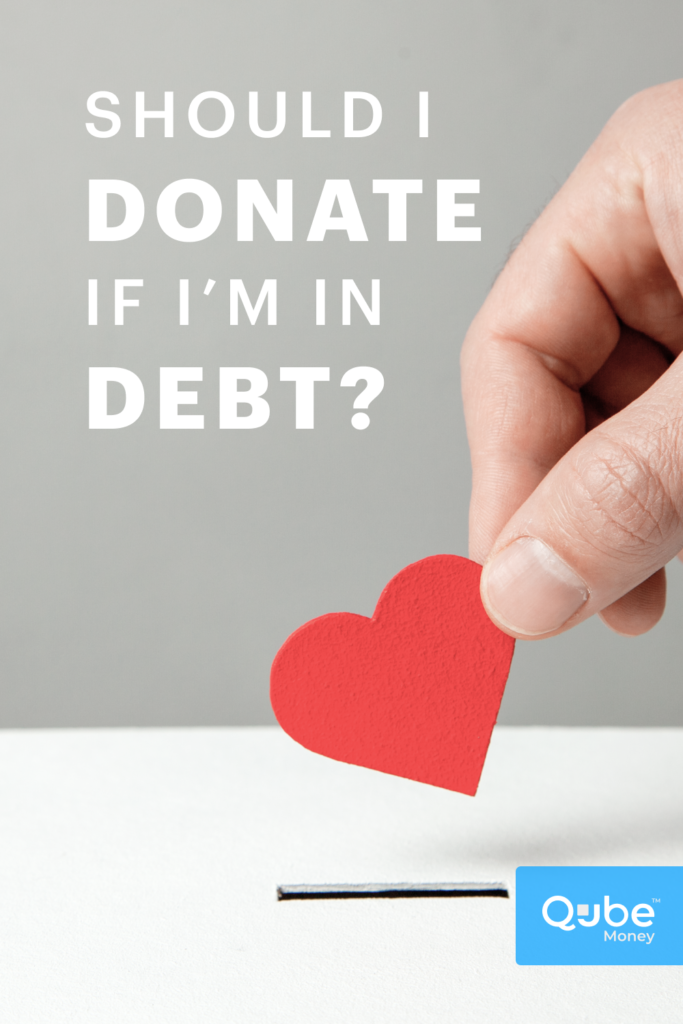Americans love to give back. In fact, according to Giving USA 2019: The Annual Report on Philanthropy for the Year 2018, individual Americans gave an estimated $427.1 billion to U.S. Charities in 2018. Giving to those in need makes you feel good and like you’re making a difference, whether big or small.
Even if it’s for a good cause, you may wonder if you should donate while in debt. Like with any other financial decision, your answer may depend on your unique financial situation. So, even if you’re passionate about a certain cause, there are other ways you can donate and they don’t cost a dime.
Read on to discover the best ways to be charitable while paying down debt.
Evaluate Your Financial Situation
Before you decide if it makes sense to donate, it’s important to evaluate your financial situation. Look at all your expenses and revolving debt balances to determine if there’s wiggle room in your budget to give to your favorite charity. For example, let’s say you have $7,000 of credit card debt and are paying an average of 15% APR. That means you’re paying about $1,050 per year on interest alone.
Therefore, it may not make sense to give to charity when you’re spending hundreds of dollars annually in credit card interest. In this case, instead of donating, you may want to get serious about paying off your credit card debt so you’ll have more disposable income to give to the causes you care about in the future.
On the other hand, if you find that your only debt is your mortgage and car payment and have extra cash after your bills are paid, you may want to give a little bit to your favorite nonprofit. Either way, it’s important to understand your budget so you can determine if it makes sense to give.
Pay Off Your Debt So You Can Donate
If you’re passionate about giving back, you can make room in your budget to donate by facing your debt. By making a plan and sticking to it, you improve your chances of getting rid of your debt for good. To help you get started, we have compiled a few suggestions to move one step closer to debt freedom.
Prioritize Your Debt
Prioritizing your debt can make it easier to manage and address once and for all. Two of the most popular methods for tackling debt include the snowball and avalanche methods. With the snowball method, you’ll focus on the smallest debt balance first.
You’ll begin by making a list of all your revolving debt and organize them starting with the smallest balance, then the second smallest balance and so on. Next, you’ll make minimum payments on everything except for the debt that has the lowest balance.
You’ll make extra payments towards the debt that has the lowest balance, regardless of the interest rate until it’s paid off. After the first balance is repaid, you can roll your payment into the debt with the second-lowest balance until it’s paid off.
With the debt avalanche method, you’ll complete a similar process. However, you’ll organize your debt balances by interest rates instead of the balance amount. You’ll start by paying off the debt with the highest interest rate, then the second-highest, and so on.
While both methods are proven to be successful, you should select the one that works for you. No matter which one you choose, the important thing is that you get serious about making a debt repayment plan and sticking to it.
Create a Solid Budget
You also need to understand what funds you have coming in and going out, so you can determine how much money you can give to your debt. Begin by creating a spreadsheet of your income and expenses. You may want to divide your expenses into variable and fixed expenses.
Once you have a solid budget in place, it’s wise to use a budgeting tool such as Qube to help you create positive spending habits. With Qube, you’re given digital envelopes for each category of your budget. You then create a designated amount you can spend with each envelope. Once you have spent the funds in a specific category, you won’t be able to spend any more money in that category. Using a tool like Qube can help you stick to a budget and not overspend.
By making a budget, you can take control of your money and speed up the debt repayment process.
Reduce Expenses
Upon reviewing your budget, you may discover that you spend more in certain areas that you thought you did. For example, you may think you only spend about $5 at Starbucks every week but upon reviewing your expenses, you find out you spend about $25 per week. By becoming aware of categories where you may overspend can help you begin to reduce your spending.
To get the entire picture of how you spend your money, you may need to track your spending for at least 2 months. This way you can see where adjustments need to be made to put more of your money toward your debt.
Increase Your Income
The more money you make, the more you can contribute to your revolving debt. You can increase your income at your current job by asking for a raise, qualifying for a bonus, or seeking a promotion to achieve a higher-paid position.
If you can’t make more money at your current job, you can look into doing a side-gig. You could drive for Uber or DoorDash to earn extra money in the evenings or on weekends. Or you could consider turning your skills into cash by taking on freelance projects in your field. Remember, if the goal is to be able to donate money while paying down debt, the extra hours you put it will all be for a higher purpose.
Best Ways to Give While You’re Paying Off Debt
Once you’ve evaluated your financial situation and are confident that you’re ready to start charitable giving, you should figure out exactly how you’ll give. There are several options that you can explore, and not all of them involve giving your money.
Donate Your Time
Your time may be as valuable as your money. Instead of giving your hard-earned dollars, you can volunteer with an organization that you care about. This way, you get the chance to see your efforts directly impact the individuals, organizations, or animals in need.
In addition to directly interacting with the cause, you may even pick up a new skill. The more skills you have, the more valuable you can become at your place of employment. By gaining more skills you may be eligible for a promotion or transition to a new career opportunity.
If you’re not sure where to start, check out your local library, church, or animal shelter to see if they need volunteers. You can also register on Volunteer Match to find a local cause to pair up with.
Ask Your Employer if They Will Donate
You may want to inquire with your employer about your company’s social responsibility policy. This policy can help you determine how your employer can get involved with your cause. Some employers will match your contributions dollar-for-dollar up to a specified amount while other employers may even triple or quadruple your contributions.
Some companies may also have volunteer grant programs. This means that the company may financially contribute to the organizations where employees regularly give their time. You may have to fill out a timesheet to prove you volunteer with the charity. Utilizing your employer to help you give back is a great opportunity to raise money for your favorite cause.
Clean Out Your Closet
Clean out your closets, garage, and attic. Then, donate everything you no longer use to a local charity. You could donate everything from books to a bicycle you no longer ride. Charities and nonprofits are often ecstatic to receive your used goods. Be sure to call ahead to see if there are specific items that they are looking for, or if they are overstocked in something. For example, a charity that serves women may have plenty of strollers but not enough car seats.
In addition to donating your items, you could get your entire family or neighborhood involved and host a clothing or used good drive. Organizing a used good drive will not only help the cause you care about but it may even bring your family and community closer together.
You may even choose to sell your items and donate the money you raise instead of donating items. While some charities may not need the items that you were ready to donate, nearly every organization can find a way to use the money to benefit the demographic that they serve.
The Takeaway
So, to give or not to give, that’s the question. Ultimately, charitable giving should not inhibit you from reaching your financial goals. Therefore, you can find ways to pay off your debt and make extra money to give more easily. Additionally, you may choose to donate your time or items until you have more money to give.As you find space in your budget for charitable giving, consider using an app like Qube. With Qube, you’ll receive help to allocate part of your money toward charitable giving while still helping you to save for and eliminate other budget items.








